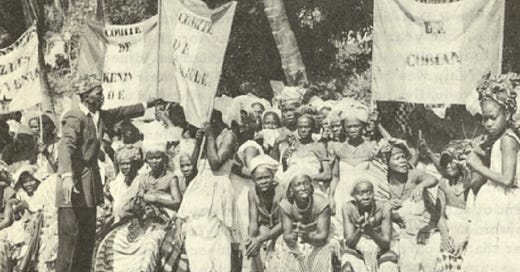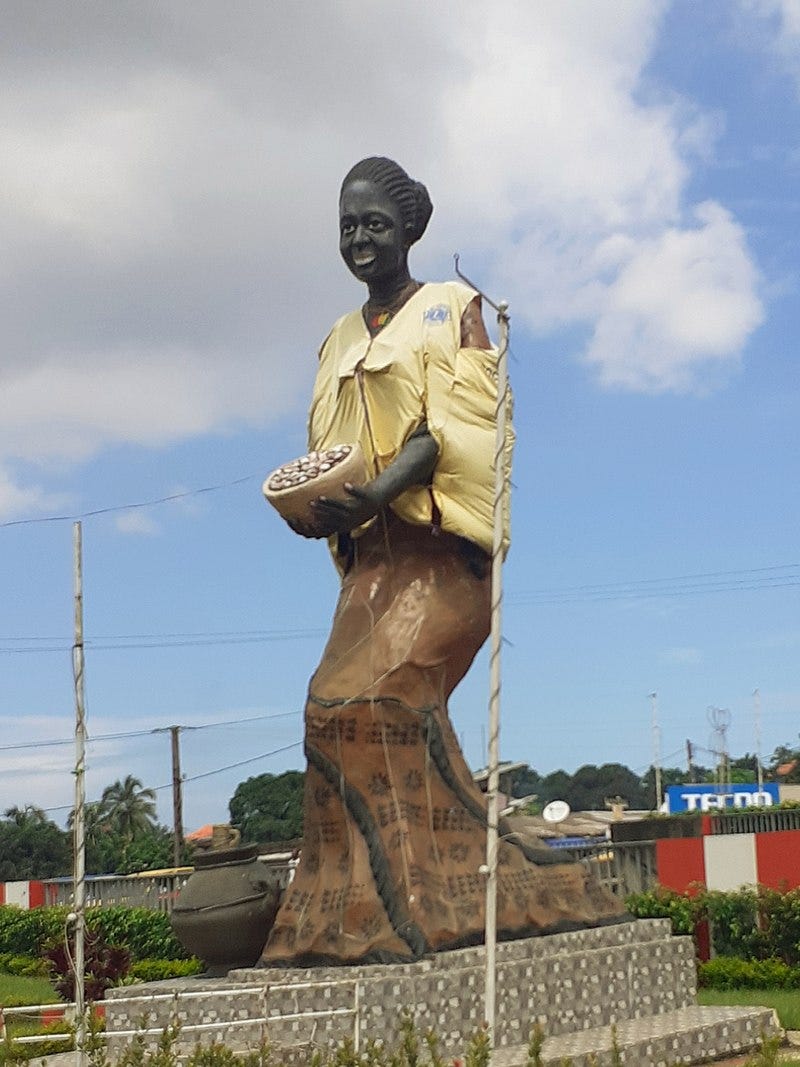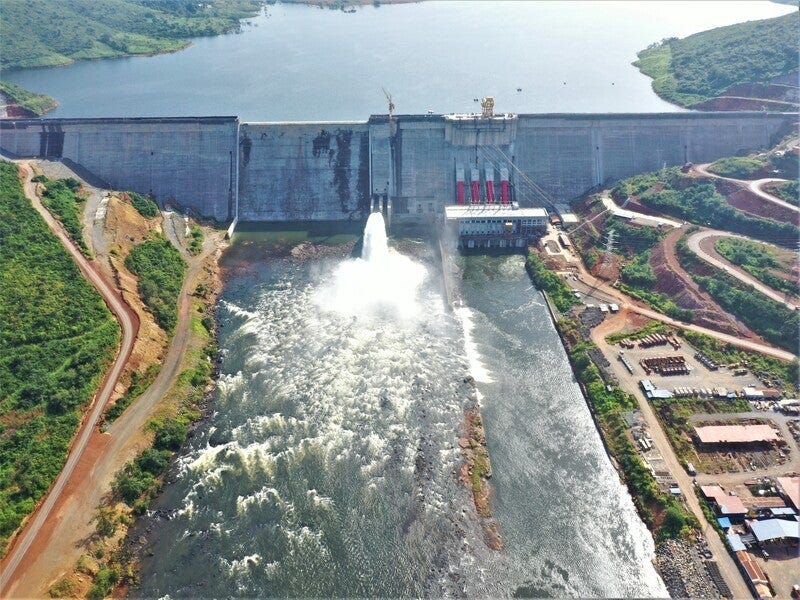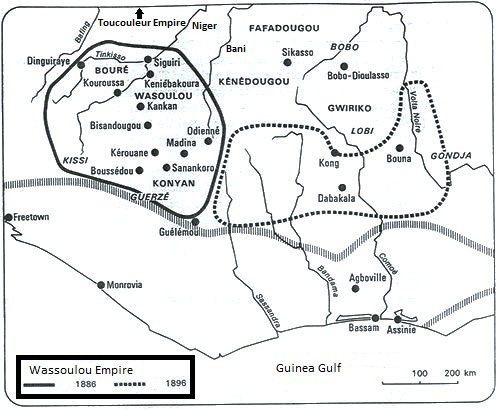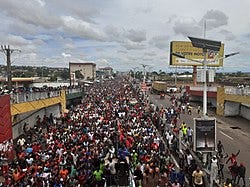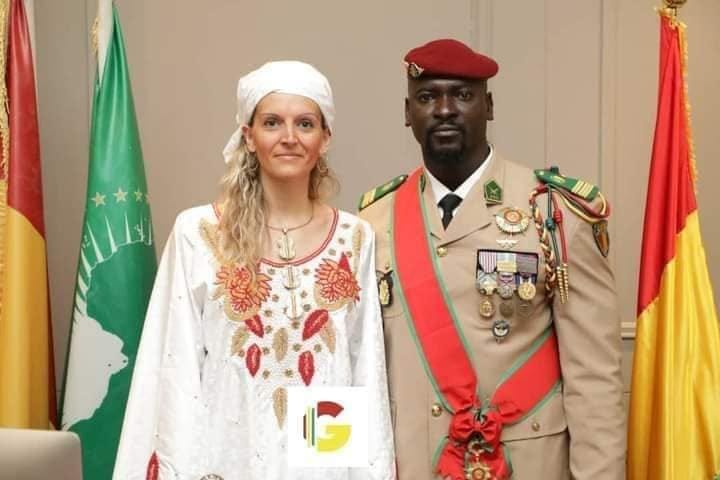The Economics & Geopolitics of Guinea (Guinea-Conakry)
This article will probably make you hate France and respect China
Guinea is a West African nation with 14.5M people (updated for January 2024), 85% of whom are Muslim with 20+ ethnic groups including Fulani (also known as Peul), Mandinka and Sousou people. Guinea comes from the word Guiné, which is what Portuguese sailors called the place when they sailed there in the 15th century. Guinea was basically a Portuguese word that meant “Land of Burnt People”.
When you look at Guinea’s post independence economic history, it has been lackluster. Guinea is a majority rural country, and their average farming yields are subsistence. When you just for inflation in 2022 prices at market exchange rates, it has stagnated for nearly 50 years, but now is finally on the upswing due to Chinese investment.
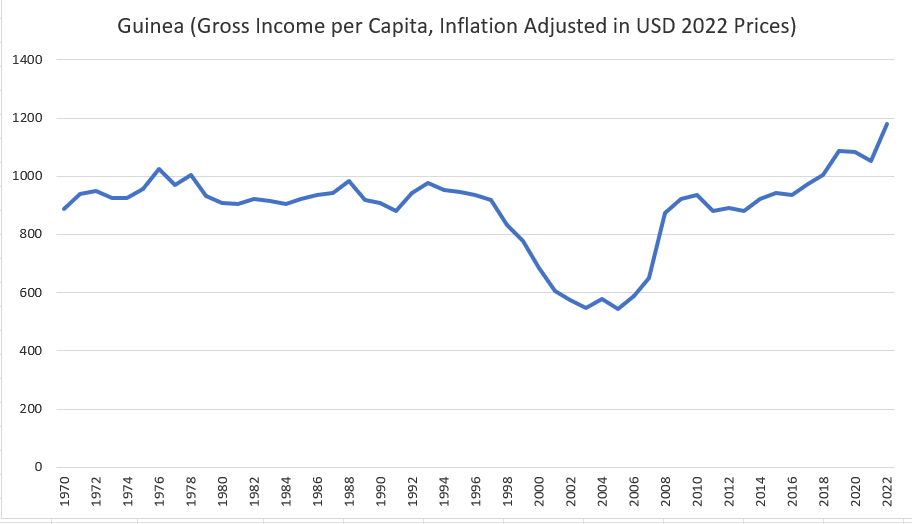
75% of the population are subsistence farmers for rice, fruits, & veggies. Guinea also has the world’s largest reserves of bauxite (used to make aluminum).
In terms of mineral production, Guinea is #2 in bauxite production and #18 in the world for gold mining production. Like most African countries, there’s an artisanal mining issue, where people die trying to extract gold and support their families since there’s no other job opportunities.
It is also a former French colony, was the second black African country after Ghana to gain independence in 1958.
Fortunately, thanks to Russian and Chinese investments and the Guinean government negotiating better mining deals, Guinea just graduated from low-income to a lower-middle income country in 2022. (The World Bank & IMF define a lower middle income country as a country where average annual income is $1136 to $4465 USD). Guinea hit $1180 income per person in 2022.
Resources:
Guinea is a typical African mining economy. In terms of billion dollar exports, Guinea sells Gold to the United Arab Emirates and sells bauxite to China. All of its other exports (cocoa, coffee, peanuts) are relatively meager that doesn’t even hit $100M for each export.
“Why hasn’t bauxite mining been a step for Guinea to develop a scaled up manufacturing aluminum industry?”
Guinea’s immediate challenge lies in the country’s lack of electricity. Smelting aluminum is highly energy-intensive, requiring 14,000 kWh of electricity per ton—far more than most metals. Without abundant, affordable electricity, Guinea cannot process its bauxite into aluminum or expand into industries like aerospace, beverage cans, or beer kegs.
Guinea's energy sector faces severe limitations. Less than half the population is connected to the grid, and the country experiences chronic power outages—1,962 in 2018 alone—due to an unreliable electricity system. The National Electricity Company of Guinea, a state-run monopoly, has been plagued by inefficiency and corruption, further stalling progress.
Cheap electricity typically comes from hydropower, coal, or gas, and while Guinea has vast hydropower potential, this remains largely untapped. The completion of the Souapiti Dam in 2021, financed by China, is a promising step toward scaling up electricity generation, but significant reforms are needed to ensure reliable distribution and governance.
Pre-Colonial History
Guinea, just like Ivory Coast, Senegal, Gambia, Mali, and Mauritania was part of the Medieval West African empires (Ghana, Mali, Songhai). The Moroccans converted the people to Islam, and traded gold and slaves with the Sub-Saharan African Empire.
In the 15th century , Portuguese explorers landed, made slave ports and traded slaves with the Songhai empire and Guinea was a major hotbed of the Atlantic slave trade. At the end of the 16th century, the Moroccans destroyed the Songhai empire in the Battle of Tondibi, and smaller empires emerged: Fulani Muslims created an Islamic State Futa Jallon & the Mandinka people made the Wassoulou empire. France crushed both of these empires in the 20th century.
French Colonialism
France didn’t even bother to educate most Guineans, at independence Guinea had a 90% illiteracy rate. Many Guineans were forced to extract rubber, diamonds, and bauxite. France forced over 50K Guineans to fight in WW1 and WW2. “Shockingly”, after forced conscription in two world wars, the Guineans thought “why are we dying for France?”
In the 1950s, France was getting slapped around trying to maintain its colonies in Algeria and Indochina (modern day Vietnam, Laos, & Cambodia). In an attempt to maintain power in West & Central Africa, French President de Gaulle gave the colonies a choice: stay in the French community and receive French aid, or leave and be cut off. The Guineans, represented by Ahmed Sekou Touré who were dissatisfied with the French treatment and saw this maneuver as textbook neocolonialism, said ““I prefer freedom in poverty to opulence in slavery".
The other French African nations overwhemingly voted to voluntarily stay in the France’s Orbit. Depending on your point of view, the reason is cognitive colonialism and/or pragmatism. Those country’s leaders stayed to keep access to French engineers, teachers, & development aid.

Ahmed Sekou Toure (1958-1984)
The Motherload of Rough Starts
Once Guinea became independent, Charles de Gaulle, the President of France immediately flexed his muscles. For two months, France destroyed and stole everything they could before leaving Guinea: unscrewing lightbulbs, removing plans for sewage pipelines in the capital, smashing windows, damaging property, and burning medicine. Paris also suspended bank credits, development assistances and diverted incoming ships bringing food. French firms left the country. France withdrew all their 3000 civil servants, doctors, engineers, businessmen, and technicians left Guinea. France even stopped paying pensions for the Guinea soldiers who fought for France in WW2.
The French President attempted execute a covert operation to murder Touré, and to proliferate a counterfeit franc currency to mess up Guinea’s currency in circulation. The operation was called “Operation Persil”. The disaster of Guinea was a warning to the other French African states to stay within the French Sphere of Influence.
Pan -African & Socialist Guinea
Touré immediately tried to get help from other African states. Touré also sought aid from Kwame Nkrumah, the president of Ghana, who loaned his government $10M ($104M in today’s money) and joined a union with Ghana in 1958, which Mali also joined also until it dissolved in 1963.
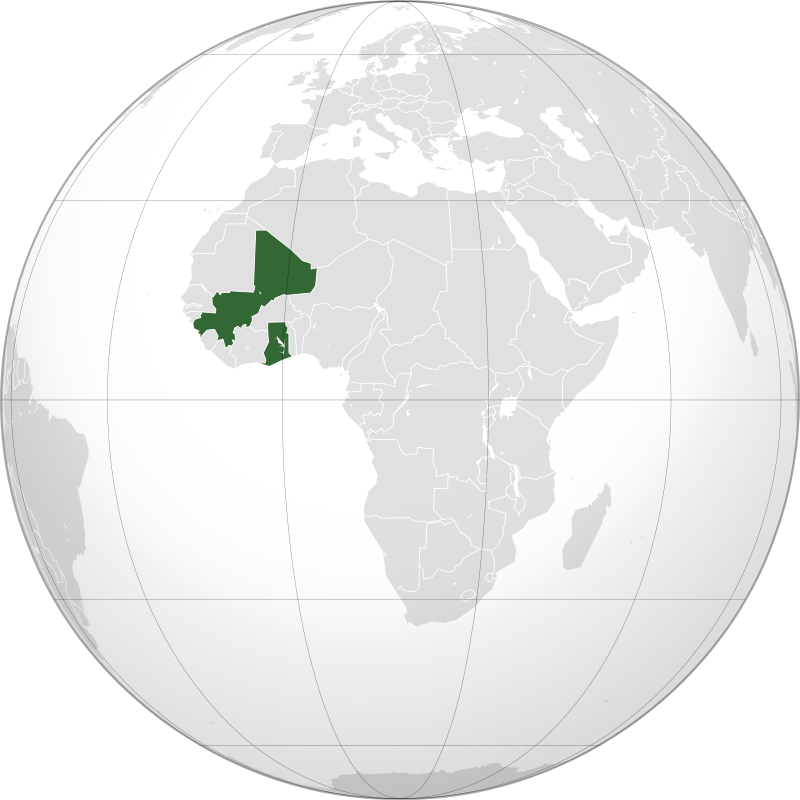
Touré became paranoid due to France trying to kill him. Touré, a former trade union leader who used to believe in democracy, quickly turned Guinea into a one party, socialist dictatorship. Touré was convinced there were 1000s of African sellouts who were French spies who would kill him, so he sent his enemies — many real, others fake — into concentration camps to be tortured and starved to death (5K to 50K people were murdered & tortured in the concentration camp Boiro). Touré banned street protests, commanded the army to send tear gas and shoot protestors and killed people for setting up political parties. Touré, a Malinke ethnic, made policies favoring his own ethnicity and tortured the Peulh people (he thought they were trying to kill him) instead of trying to foster cross-ethnic nationalism.
Guinea trying Soviet Union Socialism
Ghana and Mali alone couldn’t provide enough resources for Guinea, so Touré sought aid from Moscow, Prague, Havana, and later Beijing and modelled policies after their communist governments. In exchange for gold and bauxite, the communists provided aid & training to fund Toure’s programs. With Russian support throughout the 1960s, Touré underwent land reform, state owned control of industry, and farming collectivization.
Land Reform: For land reform, Touré seized all private owned land from French appointed and traditional chiefs, distributing the government owned equitably. To allow the state to control heavy industry, he made a state-owned monopoly on almost every business: import-export of rice, cement, banking, farming, and construction.
Collective farming: Touré also tried Stalin’s collective farming policies: instead of people owning land individually, all farms were state-owned farms or farming cooperatives. Touré had a government monopoly purchasing board that would buy the crops from the collective farms at a set price to pay the traders & farmers. Independent, middle class traders were denounced as “bourgeoise traders” and were replaced by a colossal state trading corporation. He even made an economic police force to enforce his ban on private retail trade. Touré spent millions he received from Beijing, Accra, & Moscow on making mechanized communal farms and hired people from agricultural school.
Education & Healthcare: Toure’s policies did make great strides in expanding primary health care, education, and women’s rights with his government revenue, but the disastrous consequences of his communist experiments left Guinea in disarray.
Toure’s collective farming policies, after decades of experimentation produced less cereal, vegetables, and fruits than Guinea did pre-independence. In Guinea, the crop yields from communal farm production were so low that Guinea struggled to feed itself. Guinea had to use a third of its bauxite revenues to import food, diverting money from vital, and grossly neglected, infrastructure like roads.
The prices that the government board paid the peasants eventually became below the peasants’ costs. The farmers would soon resist the government’s low stipends, while the tractors, harvesting machines, grain grinders, & tractors imported from France, Soviet Union, or East Germany were dismantled and abandoned. The 10K Guineans who went to agricultural school to manage the farming collectives weren’t taught properly on how to maintain or repair equipment. The managers also had poor relations with the local farmers.
The state run monopolies became ultra corrupt, debt-ridden, and unprofitable. Political officials and bureaucrats easily siphoned money from the state owned corporations to their pockets.
“To set up a cannery without products to can, a textile factory that lacked cotton supplies, a cigarette factory without sufficiently homegrown tobacco, and to develop… a forest region that had no roads or trucks to carry out its output — all of these gambles were taken up by ignoramuses and utopian idelaists” — Claude Rivere, a French critic of Toure’s economic policy who went inside the country and researched it.
Guinea using Russia & United States
By 1963, Touré also thought Russians wanted him dead. So he tried to maintain a “Non-alignment policy” between Russia and United States to finesse loans from both superpowers. Touré established relations with JFK in America, and loaned Touré $400M so Touré can make the Guinean mining company to extract bauxite. The company is 49% owned by Guinea and 51% owned by a consortium of American, Canadian, & Australian aluminum firms like Alcoa and Rio Tinto.
Portuguese Invasion
By 1970s, Fascist Portugal invaded Guinea and tried to start a coup, since Touré was helping Portuguese Guinea (Guinea-Bissau) & Cape Verde receive independence. This was poor timing since a cholera epidemic emerged in 1972. The Portuguese severely damaged Guinea until Portugal stopped during the 1975 carnation revolution. Nigeria, Libya, and China helped Touré survive during the war.
Toure’s U-Turn
Due to Portugal’s infiltration and Toure’s government paying female vendors starvation wages, the market women revolted around the nation.
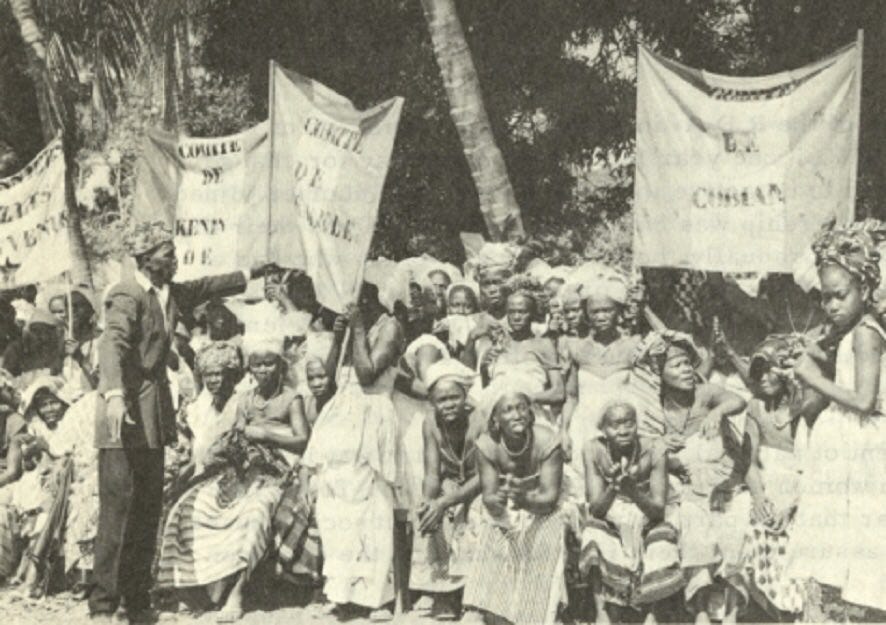
This event made Touré realized that Soviet Style- communism was not going to save his people, so he sought an IMF loan. Per IMF conditions, eliminated many price controls, and allowed more foreign investment. He reestablished stronger ties with France, and received his loan 1982. He sold off 108 economically draining and unprofitable government enterprises to pay down the $1.5B in debt that he borrowed from Washington, Moscow, Accra, Paris & Beijing.
Once Touré opened relations with France again, France agreed to pay the pensions of the 20k Guinea servicemen. Touré also released French men and women in his prison.
He realized collective farming was inefficient and privatized and removed subsides from 210 of the 360 collectives farms. This privatization scheme was swift… According to the World Bank, only 10 of the private farming firms were capable of surviving without heavy government subsidies.
By 1984, Touré died in Ohio while undergoing a heart operation at age 62. By the end of his regime, 20% of the population left the country (1M people fled) due to his executions, random imprisonment, and torture.
Colonel Lansana Conte (1984-2008)
With Touré dead, the military, lead by Lansana Conte staged a coup. Conte promised human rights and democratic elections. 200K Guineans returned home. Things were marginally better, but it was still horrifically corrupt, one party state. A coup was attempted against him by the Manlike ethnicity in 1985. Once the coup failed, he killed 100 of the alleged plotters and subjugated Manlike ethnic group.
He opened up the country to more foreign investment for mining and sought IMF support, since gold prices were declining, the guinea franc was depreciating to other currencies, Guinea’s dollar/franc/pound loans became unsustainable. So he went to the IMF and he was forced to transition Guinea into a multi-party democracy. Conde sold bankrupt state owned firms to investors and devalued the currency. Unfortunately currency devaluation makes it more expensive to import food & fuel from other countries, causing massive inflation and pain for most Guineans. Guinea, which was already one of the poorest countries got even poorer until 2003. In 1988, the average Guinean made $400 a year ($1.10 a day), already dire poverty, by 2003, the average Guinean made $340 per year ($.93 per day).Conte kept winning elections through repressing the opposition, surviving another coup attempt in 1996.
In 2001, Guinea received another IMF loan. IMF mandated that Guinea had to end consumption fuel subsides and direct those funds to healthcare, education, and/or social protection. Consumer fuel subsidies are policies intended to protect consumers by keeping prices low for fuel.(i.e. the government pays to lower the cost of gasoline for car drivers.) The subsidies had high fiscal costs, and for a country like Guinea that has trouble collecting government revenue, Guinea borrowed more to keep the subsides.
After Conte removed fuel subsides, the cost of electricity skyrocketed. In 2006 & 2007, people were sick of Conte, and people strike across the country. He violently repressed these strikes, leading to hundreds of deaths.
He died in 2008 of disease.
Moussa Dadis Camara (2008-2010)
After Conte’s death in 2008, the military, lead by Moussa Dadid Camara, launched another coup. Camara spewed out the usual "anti-corruption" rhetoric and promised to restore democracy, but surprise, surprise, he lied.
During the 50th independence anniversary, pro-democracy protestors took to the streets, and Camara responded by killing 15+ people, injuring 1,400+, and allowing the military to run amok, resulting in mass rapes and murders. America, the EU, the UN, the African Union, and the Economic Community of West African States imposed arm embargos, travel bans, asset freezes, and withdrawal of economic and military assistance. Western firms fled. The country fell into anarchy, and by 2010, Camara got shot by one of his own aides, scurrying off to Morocco for medical treatment.
Alpha Conde (2010-2021)
In 2010, Guinea tried to hold its first democratic election but it was riddled with ethnic clashes between the Fulani tribe who hated Alpha Conde and the Malinke tribe who loved him. Conde initially pushed for democracy but quickly gave up and turned to killing and jailing opponents while stifling the press. He also reformed Guinea’s mining laws to get a larger share of revenues, and Russian and Chinese firms continued to work with Conde.
By 2014-2016, Guinea was one of the worst hit countries in the Ebola outbreak, killing over 2500 people. By 2019, there were violent protests and mass civil unrest over Conde trying to change the constitution to extend his rule. Conde killed 800 people.
In 2018-2019, Guinea has signed on to China’s belt and road imitative and quickly surpassed Australia to be China’s largest bauxite provider. China has lent $20B to Guinea to develop infrastructure, in return China would get bauxite at reduced prices for 20 years. Guinea went from a tiny sliver of global bauxite production to accounting for over a fifth of worldwide bauxite production. These projects are now making new roads, highways , ports, transmission lines, and university buildings. The airport at the Capital was renovated.
Despite the issues with Ebola, thanks to Chinese investment, Guineans became the richest they have ever been. In 2010, Guineans made $670 a year ($1620 adjusted for local purchasing power) by 2021, the average Guinean made $1020 a year ($2560 adjusted for purchasing power), the average Guinean was indeed getting richer, modestly. However, the politically connected got richer extravagantly.
By 2021, Alpha Conde was removed in a military coup by Col Mamaday Doumboya.
Mamaday Doumboya (2021- Present)
This military leader employed the same military script that other military leaders have said in West Africa. “The elites have failed to promote the welfare of the people. I promise you redemption and a national unity government”. Deja Vu
After the coup, the Economic Community of West African states (ECOWAS) has suspended Guinea from the economic group and there are threats of sanctions.
Doumboya has been cozying up to China even more, which is great for energy development and infrastructure, but some Guineans are complaining. The Soupiti dam, Guinea's biggest hydropower project, displaced 16K people and destroyed 101 villages. And now, China's got its sights set on the Simandou mountains, where the world’s largest untapped iron-ore deposit (8.6B metric tons). (Chinese investment is just faster, no 7 year impact assessment tests, endless consultant fees or feasibility analyses).
It's a sweet deal for both Guinea and China. Guinea gets $15 billion in tax revenue over 25 years, which is a pretty big deal considering the country's GDP is only $16 billion as of 2021. Meanwhile, China gets to reduce its dependence on Australia. With Guinea's ore, China can build seven years' worth of airports, skyscrapers, cargo ships, and weapons at their current rate of consumption.
Despite the coups, Guinea is having the fastest economic growth and income growth ever. The question is, as China extracts bauxite, can this new leader fight corruption so state officials don’t loot the profits?
Links are underlined:
Union of African States:
https://www.worldpoliticsreview.com/the-history-behind-guinea-s-latest-coup/?one-time-read-code=53970167682837867746
https://bti-project.org/en/reports/country-report/GIN


